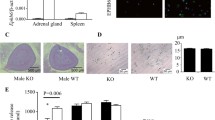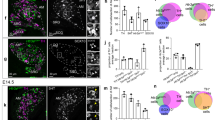Abstract
Adrenal catecholamines and steroids are important regulators of the stress response, immune function, blood pressure, and energy homeostasis. Historically, the two cell populations within the adrenal gland—the steroid-producing adrenocortical cells and the catecholamine-producing chromaffin cells—have been regarded as two independent endocrine systems. Research on adrenal physiology and pathophysiology has therefore largely focused on the individual understanding of each cell type. However, adrenal cortex and medulla appear to be interwoven and show multiple contact zones without separation by connective tissue or interstitial membranes. In vitro studies, animal models, and the analysis of human adrenal pathophysiology have demonstrated critical importance of cortical-chromaffin crosstalk for adrenal function and disease. Thus, chromaffin cells regulate steroid-hormone release by the adrenal cortex and steroids induce catecholamine production in the medulla. Consequently, disorders of the adrenal cortex have been shown to affect chromaffin cell function and vice versa. Mouse models of adrenal cortical dysfunction, such as the targeted disruption of the 21-hydroxylase- or the CRHR1 genes, show alterations in chromaffin cell function, while disruption of tyrosine hydroxylase, a key enzyme in catecholamine synthesis, impairs adrenal cortical function. Accordingly, patients with congenital adrenal hyperplasia (CAH) and Addison’s disease show reduced catecholamine biosynthesis. Immense progress in characterizing the mechanisms of chromaffin-cortical interactions has been achieved in recent years. Here, we summarize the current view on intraadrenal communication with respect to adrenal pathophysiology.
Similar content being viewed by others
References
Ait-Ali D, Turquier V, Grumolato L, et al. The proinflammatory cytokines tumor necrosis factor-alpha and interleukin-1 stimulate neuropeptide gene transcription and secretion in adrenochromaffin cells via activation of extracellularly regulated kinase 1/2 and p38 protein kinases, and activator protein-1 transcription factors. Mol Endocrinol 18(7):1721–1739, 2004.
Anderson DJ. Cell and molecular biology of neural crest cell lineage diversification. Curr Opin Neurobiol 3(1):8–13, 1993.
Beaujean D, Rosenbaum C, Muller HW, Willemsen JJ, Lenders J, Bornstein SR. Combinatorial code of growth factors and neuropeptides define neuroendocrine differentiation in PC12 cells. Exp Neurol 184(1):348–358, 2003.
Bornstein SR, Ehrhart-Bornstein M, Scherbaum WA, Pfeiffer EF, Holst JJ. Effects of splanchnic nerve stimulation on the adrenal cortex may be mediated by chromaffin cells in a paracrine manner. Endocrinology 127(2):900–906, 1990.
Bornstein SR, Ehrhart-Bornstein M, Usadel H, Bockmann M, Scherbaum WA. Morphological evidence for a close interaction of chromaffin cells with cortical cells within the adrenal gland. Cell Tissue Res 265(1):1–9, 1991.
Bornstein SR, Ehrhart-Bornstein M. Ultrastructural evidence for a paracrine regulation of the rat adrenal cortex mediated by the local release of catecholamines from chromaffin cells. Endocrinology 131(6):3126–3128, 1992.
Bornstein SR, Gonzalez-Hernandez JA, Ehrhart-Bornstein M, Adler G, Scherbaum WA. Intimate contact of chromaffin and cortical cells within the human adrenal gland forms the cellular basis for important intraadrenal interactions. J Clin Endocrinol Metab 78(1):225–232, 1994.
Bornstein SR, Breidert M, Ehrhart-Bornstein M, Kloos B, Scherbaum WA. Plasma catecholamines in patients with Addison’s disease. Clin Endocrinol (Oxf) 42(2):215–218, 1995.
Bornstein SR, Tajima T, Eisenhofer G, Haidan A, Aguilera G. Adrenomedullary function is severely impaired in 21-hydroxylase-deficient mice. FASEB J 13(10):1185–1194, 1999.
Bornstein SR, Tian H, Haidan A, et al. Deletion of tyrosine hydroxylase gene reveals functional interdependence of adrenocortical and chromaffin cell system in vivo. Proc Natl Acad Sci USA 97(26):14742–14747, 2000.
Bornstein SR, Briegel J. A new role for glucocorticoids in septic shock: balancing the immune response. Am J Respir Crit Care Med 167(4):485–486, 2003.
Brown JW, Fishman LM, Carballeira A. Studies of the neuronal transdifferentiation process in cultured human pheochromocytoma cells: effects of steroids with differing functional groups on catecholamine content and cell morphology. Steroids 63(11):587–594, 1998.
Bundey RA, Toneff T, Pottenger J, Kennedy BP, Ziegler MG, Hook VY. Agoniststimulated neuropeptide and catecholamine release from bovine adrenal chromaffin cells. Ann NY Acad Sci 971:338–340, 2002.
Cavadas C, Grand D, Mosimann F, et al. Angiotensin II mediates catecholamine and neuropeptide Y secretion in human adrenal chromaffin cells through the AT1 receptor. Regul Pept 111(1–3):61–65, 2003.
Charmandari E, Eisenhofer G, Mehlinger SL, et al. Adrenomedullary function may predict phenotype and genotype in classic 21-hydroxylase deficiency. J Clin Endocrinol Metab 87(7):3031–3037, 2002.
Cole TJ, Blendy JA, Monaghan AP, et al. Targeted disruption of the glucocorticoid receptor gene blocks adrenergic chromaffin cell development and severely retards lung maturation. Genes Dev 9(13):1608–1621, 1995.
Chrousos GP. The hypothalamic-pituitary-adrenal axis and immune-mediated inflammation. N Engl J Med 332(20):1351–1362, 1995.
Davis KT, Prentice N, Gay VL, Murray SA. Gap junction proteins and cell-cell communication in the three functional zones of the adrenal gland. Endocrinol 173(1):13–21, 2002.
Doupe AJ, Landis SC, Patterson PH. Environmental influences in the development of neural crest derivatives: glucocorticoids, growth factors, and chromaffin cell plasticity. J Neurosci 5(8):2119–2142, 1985.
Ehrhart-Bornstein M, Bornstein SR, Trzeclak WH, et al. Adrenaline stimulates cholesterol side-chain cleavage cytochrome P450 mRNA accumulation in bovine adrenocortical cells. J Endocrinol 131(2):R5–8, 1991.
Ehrhart-Bornstein M, Bornstein SR, Guse-Behling H, et al. Sympathoadrenal regulation of adrenal androstenedione release. Neuroendocrinology 59(4):406–412, 1994.
Ehrhart-Bornstein M, Hinson JP, Bornstein SR, Scherbaum WA, Vinson GP. Intraadrenal interactions in the regulation of adrenocortical steroidogenesis. Endocr Rev 19(2):101–143, 1998.
Ehrhart-Bornstein M, Haidan A, Alesci S, Bornstein SR. Neurotransmitters and neuropeptides in the differential regulation of steroidogenesis in adrenocortical-chromaffin co-cultures. Endocr Res 26(4):833–842, 2000.
Feria-Velasco A, Castillo-Medina S, Verdugo-Diaz L, et al. Neuronal differentiation of chromaffin cells in vitro, induced by extremely low frequency magnetic fields or nerve growth factor: a histological and ultrastructural comparative study. J Neurosci Res 53(5):569–582, 1998.
Finotto S, Krieglstein K, Schober A, et al. Analysis of mice carrying targeted mutations of the glucocorticoid receptor gene argues against an essential role of glucocorticoid signalling for generating adrenal chromaffin cells. Development 126(13):2935–2944, 1999.
Gallo-Payet N, Pothier P, Isler H. On the presence of chromaffin cells in the adrenal cortex: their possible role in adrenocortical function. Biochem Cell Biol 65(6):588–592, 1987.
Haidan A, Hilbers U, Bornstein SR, Ehrhart-Bornstein M. Human adrenocortical NCIH295 cells express VIP receptors. Steroidogenic effect of vasoactive intestinal peptide (VIP). Peptides 19:1511–1517, 1998.
Haidan A, Bornstein SR, Glasow A, Uhlmann K, Lubke C, Ehrhart-Bornstein M. Basal steroidogenic activity of adrenocortical cells is increased 10-fold by coculture with chromaffin cells. Endocrinology 139(2):772–780, 1998.
Jeong KH, Jacobson L, Pacak K, Widmaier EP, Goldstein DS, Majzoub JA. Impaired basal and restraint-induced epinephrine secretion in corticotropin-releasing hormone-deficient mice. Endocrinology 141(3):1142–1150, 2000.
Jones CT, Edwards AV. Release of adrenocorticotrophin from the adrenal gland in the conscious calf. J Physiol 426:397–407, 1990.
King TJ, Lampe PD. Mice deficient for the gap junction protein Connexin32 exhibit increased radiation-induced tumorigenesis associated with elevated mitogen-activated protein kinase (p44/Erk1, p42/Erk2) activation. Carcinogenesis 25(5):669–680, 2004.
Martin AO, Mathieu MN, Guerineau NC. Evidence for long-lasting cholinergic control of gap junctional communication between adrenal chromaffin cells. J Neurosci 23(9):3669–3678, 2003.
McDonald TJ, Li C, Massmann GA, Figueroa JP. Connexin 43 ontogeny in fetal sheep adrenal glands. Steroids 68(7–8):613–620, 2003.
Nussdorfer GG. Cytophysiology of the adrenal cortex. Int Rev Cytol. 1986;98:1–405.
Seidl K, Unsicker K. Survival and neuritic growth of sympathoadrenal (chromaffin) precursor cells in vitro. Int J Dev Neurosci 7(5):465–473, 1989.
Stemple DL, Mahanthappa NK, Anderson DJ. Basic FGF induces neuronal differentiation, cell division, and NGF dependence in chromaffin cells: a sequence of events in sympathetic development. Neuron 1(6):517–525, 1988.
Tai TC, Claycomb R, Her S, Bloom AK, Wong DL. Glucocorticoid responsiveness of the rat phenylethanolamine N-methyltransferase gene. Mol Pharmacol 61(6):1385–1392, 2002.
Tajima T, Okada T, Ma XM, Ramsey W, Bornstein S, Aguilera G. Restoration of adrenal steroidogenesis by adenovirus-mediated transfer of human cytochrome P450 21-hydroxylase into the adrenal gland of 21-hydroxylase-deficient mice. Gene Ther 6(11):1898–1903, 1999.
Takeda M, Dubey R, Phillips JK, Matsumoto S, Lipski J. Effects of vasopressin on isolated rat adrenal chromaffin cells. Regul Pept 106(1–3):55–65, 2002.
Tischler AS, DeLellis RA, Biales B, Nunnemacher G, Carabba V, Wolfe HJ. Nerve growth factor-induced neurite outgrowth from normal human chromaffin cells. Lab Invest 43(5):399–409, 1980.
Unsicker K, Hofmann HD. Phenotypic plasticity of cultured bovine chromaffin cells. I. Morphological changes induced by non-chromaffin cells and organ extracts, but not by mouse and bovine nerve growth factor. Brain Res 283(1):41–52, 1983.
van Dillen IJ, Mulder NH, Vaalburg W, de Vries EF, Hospers GA. Influence of the bystander effect on HSV-tk/GCV gene therapy. A review. Curr Gene Ther 2(3):307–322, 2002.
Weise M, Mehlinger SL, Drinkard B, et al. Patients with classic congenital adrenal hyperplasia have decreased epinephrine reserve and defective glucose elevation in response to high-intensity exercise. J Clin Endocrinol Metab 89(2):591–597, 2004.
Wurtman RJ, Axelrod J. Adrenaline synthesis: control by the pituitary gland and adrenal glucocorticoids. Science 150(702):1464–1465, 1965.
Yoshida-Hiroi M, Bradbury MJ, Eisenhofer G, et al. Chromaffin cell function and structure is impaired in corticotropin-releasing hormone receptor type 1-null mice. Mol Psychiatry 7(9):967–974, 2002.
Author information
Authors and Affiliations
Corresponding author
Rights and permissions
About this article
Cite this article
Schinner, S., Bornstein, S.R. Cortical-chromaffin cell interactions in the adrenal gland. Endocr Pathol 16, 91–98 (2005). https://doi.org/10.1385/EP:16:2:091
Issue Date:
DOI: https://doi.org/10.1385/EP:16:2:091




